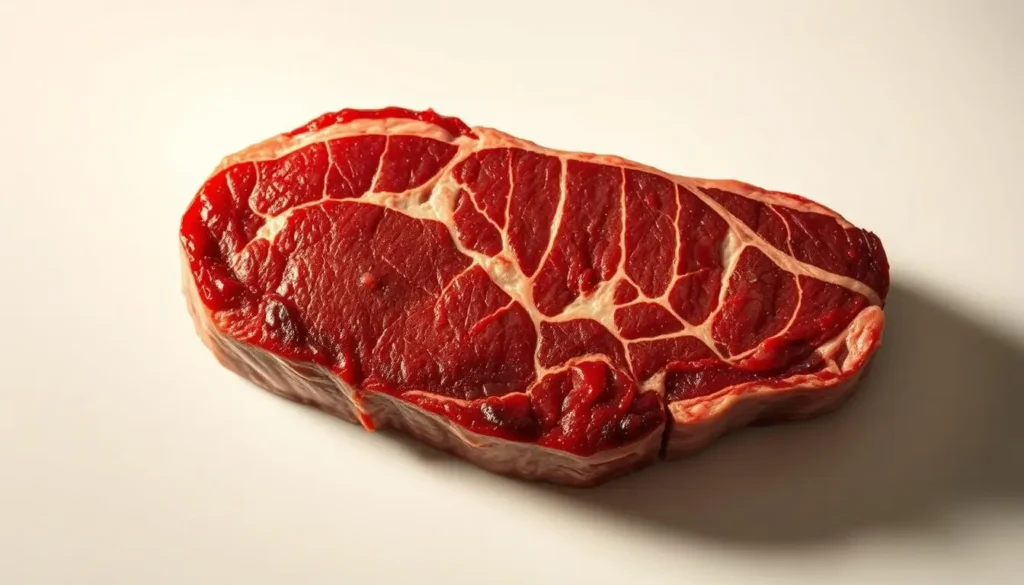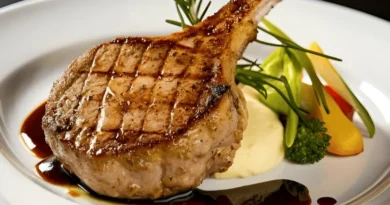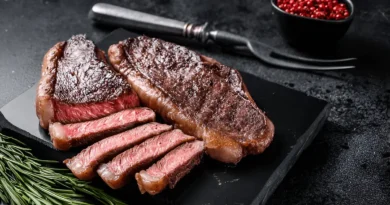Is Ribeye Healthy? A Complete Look at Ribeye Nutrition
When considering a ribeye steak, you might wonder about its health implications. Rich in protein and packed with various vitamins and minerals, Ribeye Nutrition shows that it can be a nutritious addition to your diet.
You might be surprised to learn that enjoying ribeye in moderation can provide several health benefits, including improved muscle mass and enhanced overall health due to its nutrient-rich profile. Understanding Ribeye Nutrition can help you make informed decisions about including it in your meal plans.
As you explore the nutritional value, you’ll discover that Ribeye Nutrition highlights its role as a good source of essential nutrients, contributing to its potential health benefits.
Key Takeaways
What Makes Ribeye Unique Among Beef Cuts
The ribeye steak is a favorite among beef connoisseurs due to its exceptional taste and nutritional profile. This cut is derived from the rib section, known for its rich marbling, which contributes to its tender texture and rich flavor.
Origin and Characteristics of Ribeye Steak
Ribeye steak originates from the rib primal, which spans from the 6th to the 12th ribs of the cow. The marbling within the ribeye, comprising intramuscular fat, enhances its tenderness and flavor. This characteristic marbling is a key factor in the ribeye’s popularity, as it provides a rich, beefy taste and a tender, juicy texture.
Nutritional Highlights: Ribeye steak is not only prized for its taste but also for its nutritional benefits. It is a rich source of proteins, vitamins, and minerals essential for a balanced diet.

Why Ribeye Is Popular Among Meat Lovers
Ribeye steak is cherished by many for its rich flavor and tender texture. The generous marbling throughout the cut ensures that each bite is both juicy and full of flavor. Additionally, the versatility of ribeye steak in cooking methods, from grilling to pan-searing, adds to its appeal among meat enthusiasts.
| Characteristics | Ribeye Steak | Other Beef Cuts |
|---|---|---|
| Marbling | High | Variable |
| Tenderness | High | Variable |
| Flavor Profile | Rich, Beefy | Varies by cut |
Ribeye Nutrition: A Comprehensive Breakdown
Delving into the nutritional content of ribeye steak can help clarify its health implications. Ribeye steak, a popular cut among beef enthusiasts, offers a rich flavor profile and tender texture, making it a staple in many cuisines.

Calories and Macronutrients in a Typical Serving
A typical serving of ribeye steak (about 3 ounces or 85g) contains approximately 230-250 calories, with a significant portion coming from its fat content. The exact calorie count can vary based on factors like the cut’s thickness and the level of marbling. Ribeye steak is also a good source of protein, providing about 20-25 grams per 3-ounce serving.
The macronutrient breakdown of ribeye includes:
| Macronutrient | Amount per 3 oz serving |
|---|---|
| Protein | 20-25 grams |
| Fat | 15-20 grams |
| Carbohydrates | 0 grams |
Comparing Ribeye to Other Beef Cuts
When compared to other beef cuts, ribeye steak tends to have a higher fat content, which contributes to its rich flavor and tender texture. For instance, a sirloin steak typically contains less fat than ribeye, making ribeye a more calorie-dense option. However, the nutritional differences are not drastic, and ribeye can still be part of a balanced diet when consumed in moderation.
How Cooking Methods Affect Nutritional Values
Cooking methods can significantly impact the nutritional value of ribeye steak. Grilling or pan-frying can add extra calories from oils or butter, while cooking at high temperatures can lead to the formation of potential carcinogens. On the other hand, cooking methods like sous vide or oven roasting can help retain the steak’s natural nutrients without adding extra fats.
Protein Content and Quality in Ribeye Steak
You might be surprised to learn that ribeye steak is an excellent source of protein, essential for various bodily functions. Ribeye Nutrition highlights that the protein in ribeye is not only abundant but also of high quality, making it a valuable component of a balanced diet.
Complete Amino Acid Profile
Ribeye steak contains a complete amino acid profile, meaning it provides all nine essential amino acids that your body cannot produce on its own. These amino acids are crucial for building and repairing tissues, including muscles, bones, and skin. A 3-ounce serving of ribeye can provide about 22 grams of protein.
How Ribeye Protein Supports Muscle Growth and Repair
The high-quality protein in ribeye steak supports muscle growth and repair by providing the necessary building blocks. After a workout, consuming protein-rich foods like ribeye can help in muscle recovery by promoting protein synthesis.
Protein Digestibility and Absorption
The protein in ribeye is not only rich in essential amino acids but is also highly digestible. This means your body can efficiently absorb the nutrients, maximizing the benefits of the protein consumed.
| Nutrient | Amount per 3 oz Serving | % Daily Value |
|---|---|---|
| Protein | 22g | 44% |
| Essential Amino Acids | 9g | N/A |
As noted by a nutrition expert, “The quality of protein in ribeye steak is among the best, making it an ideal choice for those seeking to improve their muscle mass and overall health.”
Understanding the Fat Profile of Ribeye
Understanding the fat in ribeye is essential for those looking to enjoy this cut without compromising their dietary goals. The fat profile of ribeye steak is complex, comprising various types of fats that contribute to its flavor, tenderness, and nutritional value.
Saturated, Monounsaturated, and Polyunsaturated Fat Content
Ribeye Nutrition shows that ribeye steak contains a mix of saturated, monounsaturated, and polyunsaturated fats. The saturated fat content is significant, which has been a point of discussion regarding heart health. However, it’s also worth noting that ribeye contains monounsaturated fats, which are considered more heart-healthy. The polyunsaturated fat content, while less prevalent, still contributes to the overall fatty acid profile.
Here’s a breakdown of the typical fat content in a ribeye steak:
- Saturated fats: Approximately 30-40% of total fat
- Monounsaturated fats: Around 40-50% of total fat
- Polyunsaturated fats: About 10-20% of total fat
Omega Fatty Acids in Ribeye
Ribeye steak is a source of omega fatty acids, including both omega-3 and omega-6 fatty acids, although in varying amounts depending on the cattle’s diet. Grass-fed ribeye tends to have a more favorable omega-3 to omega-6 ratio compared to grain-fed options.
Debunking Myths About Steak Fat
There’s a common misconception that all fat in steak is bad. However, the marbling in ribeye, which is the intramuscular fat, not only enhances the flavor and tenderness but also contains beneficial fatty acids. It’s essential to differentiate between the types of fat and understand their roles in the diet.
By being informed about the fat profile of ribeye, you can make more educated choices about how it fits into your overall dietary plan.
Essential Vitamins and Minerals in Ribeye
Beyond its rich taste, ribeye steak is a nutrient-dense food, offering a range of vitamins and minerals crucial for overall health. As you consider incorporating ribeye into your diet, understanding Ribeye Nutrition and its nutritional benefits can help you make informed choices about your meal planning.
B-Vitamin Complex in Ribeye
Ribeye steak is an excellent source of B-vitamins, which play a vital role in energy production and various metabolic processes. The B-vitamin complex in ribeye includes several key vitamins that support your overall health.
B12, Niacin, and Riboflavin Content
Ribeye is particularly rich in vitamin B12, niacin, and riboflavin. Vitamin B12 is crucial for nerve function and the production of red blood cells, while niacin supports healthy skin and metabolism. Riboflavin, or vitamin B2, is important for energy production and can help reduce the risk of certain health conditions.
Impact on Energy Production and Metabolism
The B-vitamins in ribeye steak contribute significantly to your body’s energy production and metabolic rate. By consuming ribeye, you’re supporting your body’s ability to convert food into energy efficiently.
Iron, Zinc, and Other Key Minerals
In addition to its B-vitamin content, ribeye steak is a good source of essential minerals such as iron and zinc. Iron is vital for healthy red blood cells, while zinc supports immune function and wound healing. These minerals are crucial for maintaining your overall health and preventing deficiencies.
Bioavailability of Nutrients in Ribeye
The nutrients in ribeye steak are not only abundant but also highly bioavailable, meaning your body can absorb them efficiently. This high bioavailability makes ribeye a valuable component of a balanced diet, providing you with the necessary vitamins and minerals for optimal health.
Potential Health Benefits of Including Ribeye in Your Diet
The Ribeye Nutrition profile makes it a valuable addition to a healthy diet, providing benefits such as muscle growth and immune system support. While it’s often associated with being a treat or an indulgence, ribeye can be part of a balanced dietary regimen when consumed in moderation.
Muscle Maintenance and Growth
Ribeye steak is an excellent source of high-quality protein, containing all essential amino acids necessary for muscle maintenance and growth. The protein content in ribeye can help support muscle health, making it a beneficial choice for individuals looking to maintain or increase muscle mass. Consuming adequate protein is crucial for muscle repair and growth, especially after exercise or physical activity.
Iron Absorption and Anemia Prevention
Ribeye is a rich source of heme iron, a form of iron that is more easily absorbed by the body compared to non-heme iron found in plant-based foods. Iron is essential for the production of hemoglobin, which carries oxygen in the blood. Adequate iron intake can help prevent iron-deficiency anemia, a condition characterized by fatigue, weakness, and shortness of breath.
Brain Health and Cognitive Function
Ribeye contains various nutrients that support brain health, including B vitamins and certain minerals. These nutrients play a role in maintaining cognitive function and may help reduce the risk of cognitive decline. The B-vitamin complex in ribeye, particularly B12, is important for neurological function and the synthesis of neurotransmitters.
Immune System Support
The nutrients in ribeye, such as zinc and selenium, are important for immune system function. Zinc supports the activation of cells important for immunity, while selenium acts as an antioxidant, protecting cells from damage. Including ribeye in your diet can contribute to a well-functioning immune system.
| Nutrient | Benefit | Role in Ribeye |
|---|---|---|
| Protein | Muscle maintenance and growth | High-quality protein source |
| Iron | Prevents anemia | Rich in heme iron |
| B Vitamins | Supports brain health | Contains B-vitamin complex |
| Zinc and Selenium | Immune system support | Good source of these minerals |
Potential Health Concerns with Regular Ribeye Consumption
While ribeye can be a nutritious addition to your diet, regular consumption may raise several health concerns. As with any food, understanding these risks is crucial for making informed dietary choices.
Saturated Fat and Cholesterol Considerations
Ribeye is known for its marbling, which contributes to its tenderness and flavor but also increases its saturated fat content. Consuming high amounts of saturated fat can raise your cholesterol levels, potentially increasing the risk of heart disease. It’s essential to balance your ribeye consumption with other leaner protein sources to maintain a healthy fat intake.
Environmental Contaminants and Antibiotics
The production methods used in raising cattle can impact the presence of environmental contaminants and antibiotics in ribeye. Choosing ribeye from sources that use sustainable and antibiotic-free practices can mitigate these concerns. Always look for labels that indicate the cattle were raised without antibiotics or hormones.
Processed Meat vs. Fresh Ribeye
It’s crucial to differentiate between processed ribeye products and fresh ribeye steak. Processed meats, including some ribeye products, have been linked to increased health risks due to added preservatives and higher sodium content. Fresh ribeye, on the other hand, can be part of a healthy diet when consumed in moderation and prepared using healthy cooking methods.
In conclusion, while ribeye can be a healthy choice, being aware of the potential health concerns and making informed choices about sourcing and preparation can help mitigate these risks.
How to Choose the Healthiest Ribeye
The key to enjoying a healthy ribeye lies in understanding the differences in how it’s produced and labeled. When you’re at the store or a restaurant, making an informed decision about your ribeye can significantly impact your dietary health.
To make the best choice, consider the following factors:
- The feeding practice of the cattle (grass-fed vs. grain-fed)
- Whether the ribeye is organic or hormone-free
- The grading and labeling on the product
Grass-Fed vs. Grain-Fed Ribeye
Grass-fed ribeye typically has a different fatty acid profile compared to grain-fed, often with higher levels of omega-3 fatty acids and conjugated linoleic acid (CLA). On the other hand, grain-fed ribeye may have a milder flavor and tender texture.
Some key differences include:
- Higher omega-3 fatty acids in grass-fed
- Potential for better marbling in grain-fed
- Different vitamin and mineral profiles
Organic and Hormone-Free Options
Opting for organic and hormone-free ribeye can reduce exposure to antibiotics and added hormones. These options are raised without certain practices that some consumers prefer to avoid.
Consider the benefits:
- Lower risk of antibiotic resistance
- Avoidance of added hormones
- Potential for more humane farming practices
Reading Labels and Understanding Meat Grading
Understanding labels like “USDA Prime” or “grass-fed” can help you make informed choices. Meat grading can indicate the quality and tenderness of the ribeye.
Key labels to look for:
- USDA Prime, Choice, or Select for quality
- Grass-fed or pasture-raised for feeding practices
- Organic or hormone-free for production methods
Healthy Cooking Methods for Ribeye Steak
When it comes to cooking ribeye, the method you choose can significantly impact its nutritional value. You can enjoy this delicious cut of meat while maintaining a healthy diet by adopting the right cooking techniques.
Techniques to Reduce Fat Content
Reducing the fat content in ribeye steak can be achieved through simple yet effective techniques. You can start by trimming visible fat before cooking, which not only reduces the overall fat content but also makes the steak cook more evenly.
Trimming Visible Fat
Trimming visible fat is a straightforward way to make your ribeye steak healthier. By removing the excess fat, you reduce the calorie and saturated fat intake. Use a sharp knife to carefully cut away the visible fat, taking care not to remove too much of the meat.
Draining and Blotting Methods
After cooking, draining excess fat and blotting the steak with a paper towel can further reduce the fat content. This method is particularly effective when pan-frying or grilling your ribeye. By doing so, you’re not only reducing the fat but also enhancing the overall texture of the steak.
Ideal Cooking Temperatures for Nutrient Preservation
Cooking your ribeye to the right temperature is crucial for preserving its nutrients. Overcooking can lead to a loss of vital vitamins and minerals. Use a meat thermometer to ensure you’re cooking your steak to a safe internal temperature: at least 145°F (63°C) for medium-rare, 160°F (71°C) for medium, and 170°F (77°C) for well-done.
Healthy Marinades and Seasonings
Marinating your ribeye steak can enhance its flavor without adding extra fat. Opt for marinades that are low in sugar and salt, and rich in herbs and spices. You can also use citrus juices or vinegar-based marinades, which not only add flavor but also help in tenderizing the steak.
By incorporating these healthy cooking methods into your routine, you can enjoy ribeye steak as part of a balanced diet. Experiment with different techniques to find what works best for you and your family.
Conclusion: Is Ribeye Part of a Balanced Diet?
You now understand the nutritional profile of ribeye steak and its potential health benefits. Ribeye nutrition offers a rich source of protein, vitamins, and minerals, making it a valuable addition to a balanced diet. The key to enjoying ribeye health benefits lies in moderation and mindful consumption.
When choosing ribeye, consider opting for grass-fed or organic options to maximize nutritional value. Healthy cooking methods, such as grilling or pan-searing with minimal oil, can help retain the nutritional benefits. Being aware of portion sizes and balancing ribeye with other protein sources and vegetables is crucial.
Incorporating ribeye into your diet can support muscle growth, improve iron levels, and provide essential nutrients. By understanding ribeye nutrition and making informed choices, you can enjoy this delicious cut of beef as part of a healthy and balanced diet.
FAQ
Is ribeye a healthy addition to a balanced diet?
Ribeye can be a healthy addition to a balanced diet when consumed in moderation due to its high protein and nutrient content, but its high fat content should be considered.
How many calories are in a typical serving of ribeye steak?
A typical 3-ounce serving of ribeye steak contains around 250-300 calories, although this can vary based on the cut and cooking method.
What is the protein content of ribeye steak, and is it a complete protein?
Ribeye steak is an excellent source of protein, containing about 22-25 grams per 3-ounce serving, and it is considered a complete protein because it contains all essential amino acids.
How does the fat content in ribeye compare to other beef cuts?
Ribeye is known for its marbling, which means it has a higher fat content compared to leaner cuts like sirloin or tenderloin, but the fat content can vary depending on the specific cut and how it’s trimmed.
Are there any vitamins or minerals that ribeye is particularly rich in?
Yes, ribeye is a rich source of several B-vitamins, including B12, niacin, and riboflavin, as well as minerals like iron, zinc, and selenium, making it a nutrient-dense food choice.
Can cooking methods affect the nutritional value of ribeye steak?
Yes, cooking methods can significantly impact the nutritional value of ribeye; for example, grilling or pan-frying can add extra fat, while cooking to the right temperature can help retain its nutrients.
What is the difference between grass-fed and grain-fed ribeye in terms of nutrition?
Grass-fed ribeye tends to be higher in certain nutrients like omega-3 fatty acids and conjugated linoleic acid (CLA), and lower in saturated fats compared to grain-fed ribeye, although the nutritional differences can vary.
How can I make ribeye a healthier part of my diet?
To make ribeye a healthier choice, consider opting for grass-fed or leaner cuts, trimming visible fat, using healthy cooking methods like grilling or broiling, and consuming it in moderation as part of a balanced diet.









